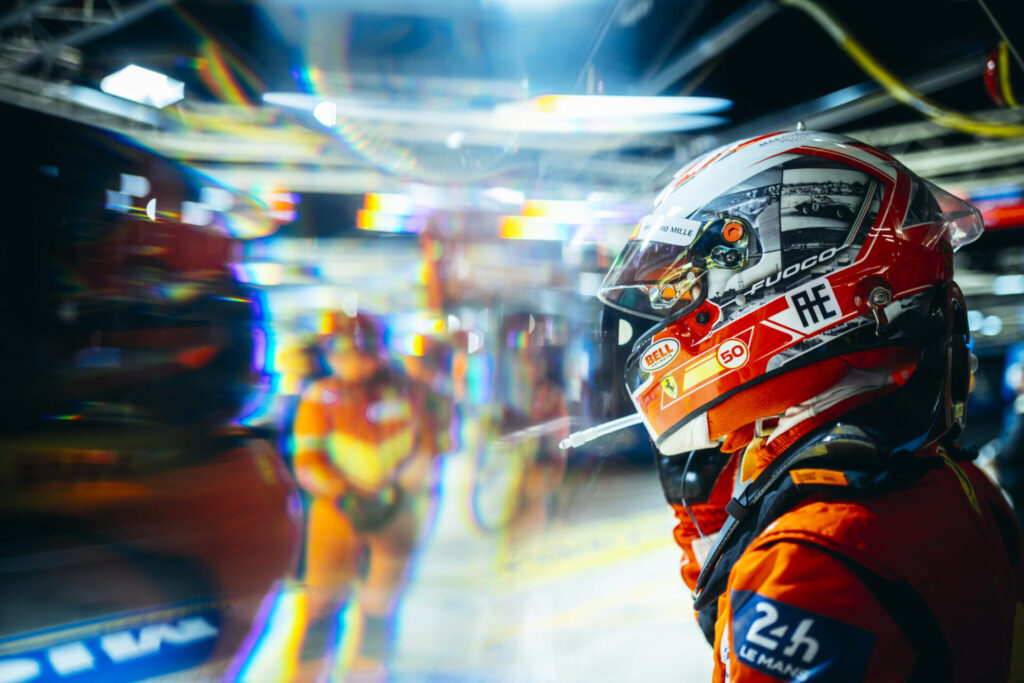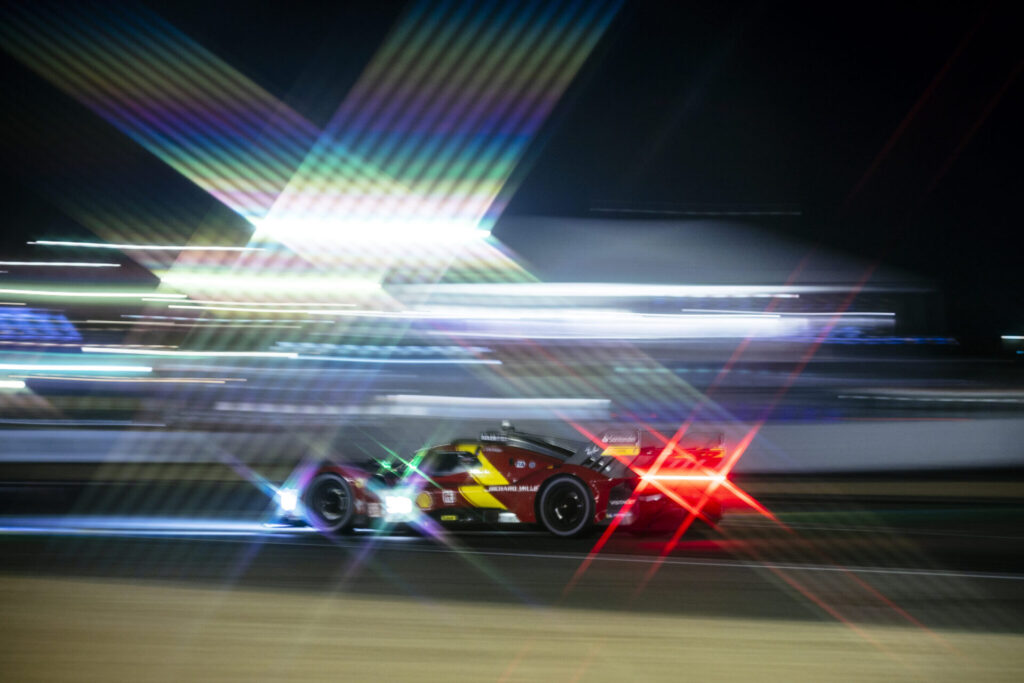This year’s edition of the 24 Hours of Le Mans will go down in history: celebrating its 100th birthday this year, the race will see many legends, including Ferrari, fight for victory. Whether you will be following the struggle on the track, in front of the TV or in La Squadra Ristorante, you should know a handful of key facts. Here they are.
The 24 Hours of Le Mans is celebrating its centenary this year. Over the course of these hundred years, the event has grown to become unique not only in motorsport, but in world sport in general. The most famous drivers in history attempt to win the Triple Crown of Motorsport, which, according to an unwritten rule, is donned after winning the Formula One Monaco Grand Prix, the Indianapolis 500 and Le Mans. For the fans, on the other hand, it is an event that can almost rival the cycling Tour de France or the final match of the American Super Bowl.
This year’s edition of the world’s most famous endurance race will be special for many more reasons than just the anniversary itself. Spectators will witness perhaps the most interesting battle for overall victory in decades. A total of 62 cars, divided into three classes (+ one joining on a ‘Garage 56’ basis), will take to the start line. Among them there will be: Ferrari, Porsche, Oreca-Gibson, Porsche and… the Chevrolet Camaro from NASCAR. Three drivers will take turns in each car, including Formula 1 stars like Robert Kubica. We will also see famous figures in the paddock, among them, inevitably, actor Patrick Dempsey, who has been fielding his Dempsey-Proton Racing team here for several years now.
The race at Le Mans is a huge undertaking that is impossible to absorb in its entirety without regularly following the world of endurance racing, or at least reading a brief recap of the key facts in this guide. What lies ahead is 24 hours of great sporting excitement and sights that will go down in history. So it’s worth knowing more than just what time the race starts and where to watch it.

Since the first edition on 26-27 May 1923, the 24 Hours of Le Mans has invariably been special for the same reason. It represents the ultimate test not only of speed but also of endurance – of machines and people alike. I remember it well from my first visit to this race in 2009. I was filled with excitement after the start, until eventually it started to get dark and fatigue set in. I looked at my watch and found it was 10pm – we were only a quarter of the way through the race!
Anyone who watched the television broadcasts of the race on Sunday mornings will no doubt remember the images of the mechanics sleeping in the corners of the garages. The fatigue of the crews is truly immense – all the more so when you consider that they already have a week of testing, practice and qualifying behind them.
There have been other 24-hour races over the years, or even longer endurance trials. Most of these, however, have not survived to our time, and none of those that have succeeded have even come close to the status enjoyed by this French classic. It has witnessed the creation of some of the greatest legends of drivers and teams, such as Ferrari and Porsche, and duels that have gone down in history, such as Ford’s against Ferrari in 1966. The spirit of this great past can still be felt there all the time and is nurtured largely by the same teams or even specific individuals.

Much of the charm of this race lies in the fact that it still runs roughly through the same places and on the same roads as a century ago. Today, the lap of the circuit officially known as Circuit de la Sarthe consists in small part of the homologated, permanent Circuit Bugatti, with which it shares a starting straight, boxes, and a few corners. However, the majority of its 13,626m lap (almost twice as long as the longest circuit in Formula 1, the equally historic Spa-Francorchamps) is on public roads and still runs through the same villages of Arnage and Mulsanne, well known to motoring fans.
The circuit at Le Mans is not only exceptionally long, but also exceptionally fast. As much as 85% of the lap distance is completed with the throttle down, largely on the long straights. The track’s unique characteristics have a key impact on the cars that compete here. Even though they also compete at other venues and other series around the world over the course of the season, they are largely designed for just two very long straights: the Mulsanne and the one that follows it into the Indianapolis corner. On the first of these, which is as long as 6 kilometres, car speeds began to exceed as much as 400 km/h in the late 1980s, so before the 1990 edition the straight was divided by two chicanes. However, it is still a race where cars are driven at unprecedented speeds around the clock.

A number of factors come together to make it so. From 2021, the top class of this race is no longer made up of Le Mans Prototypes (LMP cars), but so-called Hypercars (Le Mans Hypercar). This change has taken place in order to reduce the costs needed to compete (they have been reduced by around half), to bring the competing cars closer to their road-going counterparts, and to introduce technologies that will be more applicable to manufacturers for use in their series models (hybridisation).
This year’s edition is therefore not the first in which the new rules are in place, but the first in which they really work. After a couple of years of watching a virtually unthreatened Toyota deliver its space-age prototypes at the top placings to the finish line, the starting list of cars with a real chance of winning this year looks like a line-up of some of the greatest icons in motorsport history. Toyota and Glickenhaus, competing in previous editions, are joined by Ferrari, Peugeot, Porsche and Cadillac returning to the top class after 50 years. Next year, Alpine, BMW, Lamborghini and Acura will add to the line-up.
The success of the new regulations also lies in the fact that they allow for a great deal of diversity in designs. While to the layman all Formula 1 cars look roughly the same, here each design has its own unique character due to a noticeably different concept. So in the field we have a hypercar with an engine from a road car (Ferrari 499P with V6 from a Ferrari 296 GTB), with a naturally aspirated 5.5-litre V8 engine (Cadillac V-Series.R) and even without a rear wing (Peugeot 9X8).
When watching the race, it is worth being aware that hypercars were created using two different methods. Some of these are the work of manufacturers through and through: Ferrari, Toyota, Peugeot and even tiny Glickenhaus and Vanwall have gone down this path. Porsche, Cadillac and Alpine, on the other hand, use the so-called LMDh rules, which allow the use of many off-the-shelf parts developed by other racing specialists, including the electrical part of the drivetrain and the entire chassis by one of four manufacturers: ORECA, Dallara, Ligier or Multimatic.
The rules in this regard are complicated: cars created entirely by manufacturers have certain privileges, including the possibility of using a four-wheel drive. On the other hand, other standards limit their use (the possibility of using the electric part of the front-wheel drive only after achieving a certain, fairly high speed). On top of this, there is also the somewhat controversial ‘Balance of performance’ system, which allows the organisers to speed up or slow down a particular structure in a rather arbitrary way, so that in the end the battle for 24 hours is fierce and spectacular.

As many as 16 hypercars will compete in this year’s edition. These will include: Ferrari, Porsche, Toyota, Peugeot, Cadillac, Vanwall and Glickenhaus. However, the start list does not end there. We can still see a rich line-up in the LMP2 class, which has been developed in recent years in the face of a dry spell among the faster prototypes, with 24 Oreca 07 – Gibson cars competing. The competition in this corner of the race will be particularly interesting for the Poles, as it is in this class that Team WRT, with Robert Kubica, and the Polish Inter Europol Competition team, which has a real chance of victory, will start. Jakub Śmiechowski will appear in one of the two cars sent from near Warsaw.
A long-standing tradition of the 24 Hours of Le Mans is the division of the field into faster prototypes and GT cars. This year is the last time we will witness this formula in its current form, which has already been reduced exclusively to the LMGTE Am class. Relatively old designs are already competing in it: Ferrari 488 GTE Evo, Porsche 911 RSR, Aston Martin Vantage AMR and Chevrolet Corvette C8.R. Next season, these will be replaced by the new-type GT3 class. What to expect from it has already been demonstrated by Ferrari in its all-new 296 GT3.

The best chance that you do is if you are interested in GT class racing. After all, the realities of endurance racing are peculiar and, from what I’ve been able to learn from the drivers themselves, driving even hypercars is much closer to driving GT cars than Formula 1 cars. Ferrari has therefore relied mostly on drivers it has worked with for many years as part of the Italian AF Corse team that is part of the GT (and now hypercar) programme. The exception is current Scuderia Ferrari reserve driver Antonio Giovinazzi.
Among the 186 names on the start list, however, there are as many as 18 that motorsport fans may know from F1. In addition to Robert Kubica, these will include Kamui Kobayashi, Sebastien Buemi, Brendon Hartley (currently all at Toyota), Jean-Éric Vergne and Paul di Resta (Peugeot), Esteban Gutiérrez (Glickenhaus), Jan Magnussen (father of Kevin, who competed in Formula 1 in the 1990s – and is now driving to Le Mans with the Polish Inter Europol team), or Jenson Button (who will now start in a NASCAR-approved Chevrolet Camaro under special rules).

In keeping with long-standing tradition, the 24-hour trial will begin on the second Saturday in June (this year it is 10 June) at 4 p.m. The race is covered in its entirety by the Eurosport channel. You can watch the 24 Hours of Le Mans at home, but you can also watch it in a larger group of like-minded fans ready to stay up all night. This year, such an opportunity is offered by La Squadra Ristorante, where the entire race will be broadcast non-stop for motorsport fans – come visit ul. Bocheńskiego 109 in Katowice!
